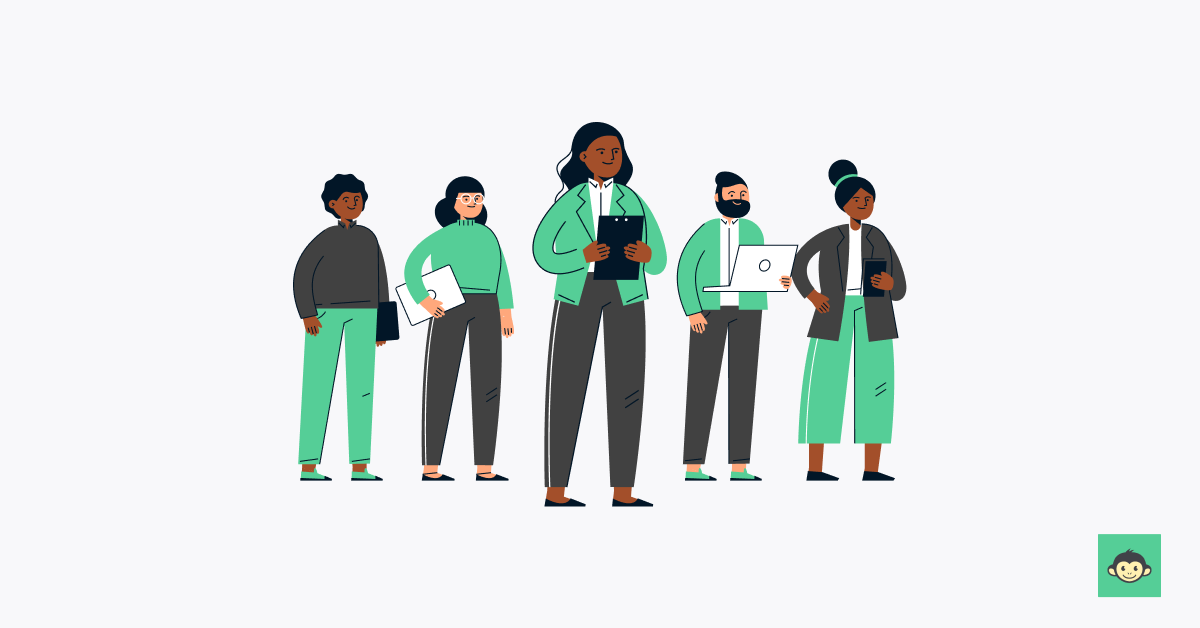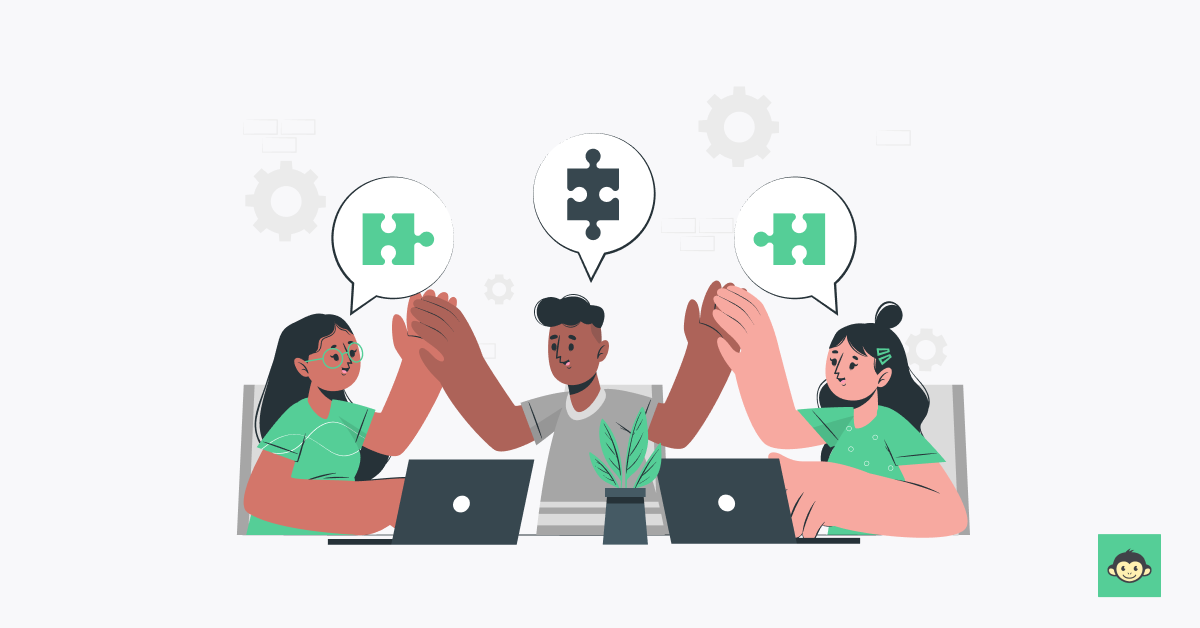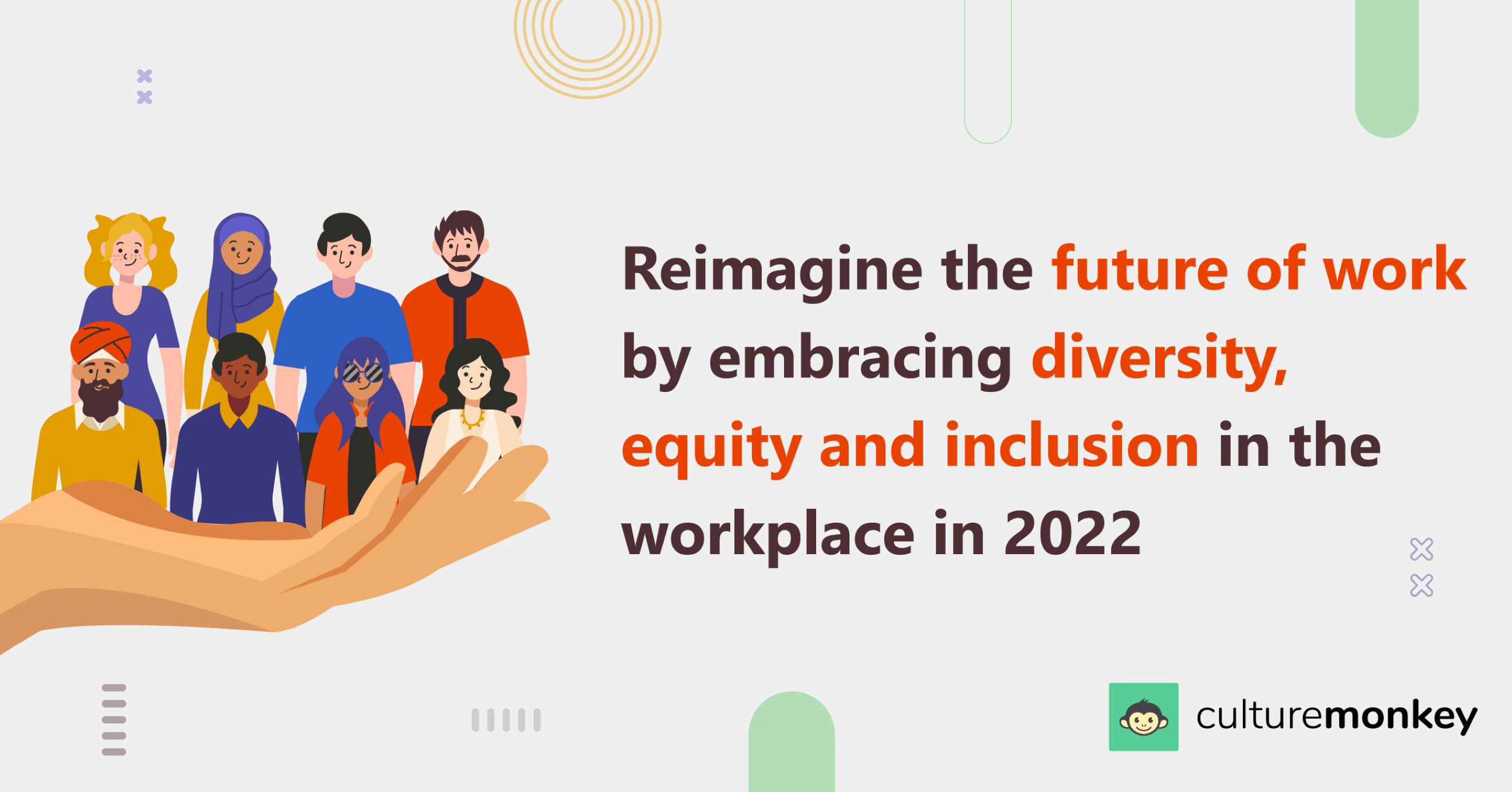25 Different types of diversity in the workplace you should know in 2024

Imagine a bland, monochromatic painting. Sure, it's technically art, but it lacks the vibrancy and depth that comes from a diverse palette.
The same goes for workplaces. While basic functionality might exist, true innovation and success blossom from a richer tapestry of experiences and diverse backgrounds.
Diversity in the workplace isn't just a feel-good buzzword. It's the strategic inclusion of individuals from a variety of backgrounds, cultures, and abilities.
This fosters a dynamic environment where different perspectives collide, sparking creativity and problem-solving. It also allows companies to better understand and cater to a wider customer base.
But what exactly constitutes "diversity in the workplace”? It goes far beyond just race and gender.
This blog dives deep into 25 distinct types of diversity, from the commonly recognized age and sexual orientation to often overlooked aspects like neurodiversity and socioeconomic background.
By understanding these various dimensions, companies can build a more inclusive and successful work environment for everyone.
So, get ready to expand your understanding of diversity. Let's explore the unique threads that can be woven together to further functional diversity and create a truly thriving workplace culture.
What is diversity in the workplace?

Diversity in the workplace refers to the variety of differences among people in an organization. These differences can include, but are not limited to, factors such as race, ethnicity, gender, age, sexual orientation, religion, socioeconomic status, physical and mental abilities, and more.
The concept of diversity goes beyond just visible characteristics and encompasses a range of perspectives, experiences, and backgrounds.
Promoting diversity in the workplace is about creating an inclusive environment that values and respects the unique attributes of all individuals.
It recognizes that a diverse workforce can bring a wealth of perspectives, ideas, and talents, which can contribute to innovation, creativity, and overall organizational success.
In addition to being a moral and ethical imperative, many organizations also recognize the business benefits of diversity, such as improved decision-making, better problem-solving, increased adaptability, and a more positive organizational culture.
Companies often implement diversity and inclusion initiatives to actively foster an environment where employees from various backgrounds feel welcome, supported, and empowered to contribute their best work.
Why is diversity in the workplace important?

Diversity in the workplace is important for several reasons, and organizations that actively promote diversity and inclusion can experience a range of benefits.
Here are some key reasons why diversity is considered crucial in the workplace:
- Innovation and creativity: A diverse workforce brings together individuals with different perspectives, experiences, and backgrounds. This diversity of thought can lead to more innovative ideas and creative solutions to problems, fostering a culture of continuous improvement and adaptability.
- Better decision-making: Diverse teams can make more well-rounded and informed decisions. When people with different viewpoints and experiences collaborate, they are more likely to consider a broader range of factors, leading to more comprehensive and effective decision-making.
- Enhanced employee performance: Employees are likely to perform better when they feel included, valued, and supported. A diverse and inclusive workplace can contribute to higher employee morale, engagement, and overall job satisfaction, leading to improved individual and collective performance.
- Market competitiveness: As businesses operate in increasingly global and diverse markets, having a workforce that reflects the diversity of customers and clients can be a strategic advantage. Companies that understand and connect with diverse consumer bases are often more competitive in the marketplace.
- Attracting and retaining talent: Organizations that prioritize diversity are often more attractive to a wider pool of talent. A diverse and inclusive workplace can help attract individuals who appreciate and seek out environments that value their unique contributions. It also contributes to higher employee retention rates.
- Legal and ethical considerations: Many countries and regions have laws and regulations promoting equal employment opportunities and prohibiting discrimination. Complying with these laws is not only a legal requirement but also an ethical responsibility for organizations.
- Improved company reputation: Companies that are known for their commitment to diversity and inclusion often enjoy a better reputation among consumers, partners, and the public. This positive reputation can lead to increased customer loyalty and stronger business relationships.Enhanced problem-solving capabilities: Diverse teams are often better at problem-solving because they bring a variety of perspectives and approaches to the table. This can lead to more effective and innovative solutions, as well as the ability to address complex challenges more efficiently.
Difference between internal and external diversity

Internal diversity and external diversity refer to different aspects of ethnic diversity within and outside an organization, respectively.
1. Internal diversity
- Definition: Internal diversity focuses on the diversity that exists within an organization itself, among its employees, teams, and leadership.
- Examples: This includes variations in race, ethnicity, gender, age, sexual orientation, religion, education, skills, and any other characteristics that can be found among the employees of a company.
- Importance: Fostering internal diversity is crucial for promoting a varied and inclusive workplace, which can lead to benefits such as improved creativity, innovation, and overall organizational performance.
- Additional insights: Internal diversity helps create a more dynamic and resilient organizational culture by incorporating a wide range of perspectives and experiences. This diversity can lead to better problem-solving and decision-making, as diverse teams are often more effective at considering multiple viewpoints.
- Strategic alignment: Aligning internal diversity initiatives with organizational goals ensures that diversity efforts are integrated into the company's core values and operations, promoting a sustainable and inclusive culture that drives long-term success.
2. External diversity
- Definition: External diversity refers to the broader context of diversity beyond the organizational boundaries. It considers the diversity present in the external environment, including the market, customer base, and community.
- Examples: External diversity takes into account the diversity of customers, clients, suppliers, and the overall demographic and cultural diversity in the regions where the organization operates.
- Importance: Understanding and addressing external diversity is essential for businesses to adapt to different market needs, connect with a diverse customer base, and navigate the complexities of a globalized world. It also ties into the concept of corporate social responsibility (CSR).
- Additional insights: Both internal and external diversity are interconnected, as the diversity within an organization can influence its ability to engage effectively with diverse external stakeholders. Companies that excel in both areas often have a competitive advantage in innovation and market relevance.
- Strategic alignment: Aligning internal and external diversity strategies ensures that a company not only fosters an inclusive internal culture but also reflects that inclusivity in its external interactions and branding. This alignment can enhance overall business sustainability and reputation.
What are the 25 types of diversity in the workplace?

Diversity in the workplace encompasses a wide range of dimensions, and while there might not be an exhaustive and universally agreed-upon list, here are 25 different types of diversity.
1. Age Diversity
Age diversity refers to the differences in age among employees. A diverse age range in the workplace can contribute to a wealth of experiences, perspectives, and skills, promoting intergenerational collaboration and learning.
2. Gender diversity
Gender diversity focuses on the balance between male and female employees. A gender-diverse workplace strives for equal opportunities and recognizes the unique contributions of individuals regardless of their own gender identity.
3. Race and ethnicity
Race and ethnicity diversity involves acknowledging and valuing differences in racial and ethnic backgrounds. Embracing this diversity promotes inclusivity and helps break down racial diversity cultural barriers within the organization.
4. Sexual orientation
Sexual orientation diversity encompasses the range of sexual orientations among employees. Fostering an inclusive environment for individuals of different sexual orientations promotes a culture of acceptance and understanding.
5. Religious beliefs
Religious diversity considers the various religious beliefs and practices of employees. Embracing religious diversity involves creating an inclusive environment that accommodates different faiths and respects individual beliefs.
6. Disability status
Disability diversity recognizes individuals with different physical or cognitive abilities. Promoting accessibility and accommodating diverse abilities contributes to a more inclusive workplace.
7. Educational background
Educational diversity involves recognizing differences in educational qualifications and backgrounds among employees. It highlights the value of diverse skills and knowledge acquired through various educational paths.
8. Cultural background
Cultural diversity encompasses the diverse cultural backgrounds and traditions of employees. Recognizing and celebrating cultural differences fosters a rich and inclusive organizational culture.
9. Language diversity
Language diversity acknowledges variations in languages spoken by employees. Creating a workplace that values linguistic diversity and multilingualism enhances communication and inclusivity.
10. Nationality
Nationality diversity considers the different cultures and countries of origin of employees. Embracing nationality diversity promotes a global mindset and enriches the organization with a range of perspectives.
11. Socioeconomic status
Socioeconomic diversity addresses differences in economic and social status among employees. A diverse socioeconomic mix contributes to a more representative and equitable workplace.
12. Family status
Family status diversity recognizes variations in family structures, including single, married, or individuals with children. Acknowledging diverse family situations promotes work-life balance and inclusivity.
13. Military service
Military service diversity involves recognizing employees with a military background. Supporting veterans and active-duty personnel fosters a culture of appreciation and understanding.
14. Political affiliation
Political affiliation diversity acknowledges differences in political beliefs among employees. Encouraging open dialogue and respecting diverse political perspectives contributes to a more inclusive workplace.
15. Work experience
Work experience diversity considers variations in professional backgrounds and career paths. Embracing diverse work experiences brings a range of skills and insights to the organization.
16. Thinking styles
Thinking style diversity recognizes differences in cognitive approaches and problem-solving techniques. Leveraging diverse thinking styles enhances creativity and innovation within teams.
17. Communication style
Communication style diversity acknowledges variations in how individuals prefer to communicate. Recognizing and adapting to different communication styles promotes effective collaboration.
18. Work preferences
Work preferences diversity considers differences in work styles, such as preferences for collaboration, independence, or specific work environments. Respecting diverse work preferences enhances employee satisfaction.
19. Personality types
Personality type diversity recognizes differences in individual personalities, such as introversion or extroversion. Appreciating diverse personalities contributes to a harmonious and balanced workplace.
20. Parental status
Parental status diversity considers differences in employees' parental roles and responsibilities. Creating a family-friendly workplace supports employees in their parenting responsibilities.
21. Appearance
Appearance diversity acknowledges differences in physical appearance, including factors like dress, grooming, and personal style. Promoting acceptance of diverse appearances contributes to a more inclusive workplace culture.
22. Neurodiversity
Neurodiversity recognizes and values differences in neurological conditions and cognitive functioning. Fostering an inclusive environment for neurodiverse individuals promotes a diverse and talented workforce.
23. Marital status
Marital status diversity considers differences in employees' marital status, including single, married, divorced, or widowed. Respecting diverse marital statuses contributes to a more diverse and inclusive workforce and workplace culture.
24. Geographic location
Geographic location diversity recognizes differences in employees' places of origin and residence. Embracing geographic diversity can bring varied regional insights and perspectives, enriching the organization's understanding of different markets and cultures.
25. Educational specialization
Educational specialization diversity acknowledges the range of academic disciplines and fields of study employees have pursued. Valuing diverse educational specializations can enhance problem-solving and innovation by incorporating knowledge from various domains.
Types of diversity benefits

Embracing diversity in the workplace can yield a variety of benefits, contributing to the overall success and effectiveness of an organization. Here are some key types of diversity benefits:
Increased adaptability
A diverse workforce is more adaptable to change. Different backgrounds and life experiences can provide a pool of skills and approaches that can help organizations navigate challenges and respond effectively to evolving circumstances.
Enhanced problem-solving
Diverse teams bring a variety of problem-solving approaches. When faced with complex challenges, the collective intelligence and diverse perspectives within the team can lead to more effective and innovative solutions.
Expanded market reach
A diverse workforce can better understand and connect with a diverse customer base. This understanding enhances the organization's ability to reach and appeal to a wider range of markets, increasing competitiveness.
Talent attraction and retention
Organizations that prioritize diversity are often more attractive to a broad pool of talent. A diverse and inclusive workplace not only attracts diverse candidates but also contributes to higher employee retention rates.
Positive organizational culture
Fostering diversity and inclusion creates a positive organizational culture. Employees feel valued, respected, and supported, leading to increased job satisfaction, engagement, and a sense of belonging.
Global perspective
Diversity in the workplace provides a global perspective. Organizations with employees from diverse geographic location cultural backgrounds are better positioned to understand and navigate international markets and business landscapes.
Legal compliance
Embracing diversity helps organizations comply with legal and regulatory requirements related to equal employment opportunities. This compliance reduces the risk of legal issues and promotes a fair and ethical work environment.
Corporate social responsibility (CSR)
Demonstrating a commitment to diversity aligns with principles of corporate social responsibility. Organizations that actively promote diversity contribute positively to social progress and community well-being.
Characteristics of diversity in the workplace
Workplace diversity encompasses a multitude of characteristics that collectively contribute to a rich and inclusive organizational environment.
Firstly, demographic characteristics such as age, gender, race, and ethnicity play a significant role in shaping the organizational diversity landscape.
A diverse mix of individuals across these dimensions brings varied perspectives, fostering a dynamic and innovative workplace culture.
Beyond demographics, diversity in educational backgrounds, skill sets, and work experiences enhances the depth of talent within the organization.
This diversity of expertise encourages collaborative problem-solving and ensures a well-rounded approach to challenges.
Additionally, acknowledging differences in communication styles, thinking preferences, and personality traits is crucial. Understanding and respecting these nuances foster effective teamwork and promote a positive, inclusive workplace culture.
Furthermore, diversity encompasses socio-economic status, religious beliefs, and sexual orientation, among other factors. Embracing these dimensions ensures that the workplace accommodates and values the uniqueness of each individual.
Successful organizations recognize that diversity is not just a compliance measure but a strategic asset, contributing to improved decision-making, increased adaptability, and a competitive edge in a globalized marketplace.
Why does diversity matter in the workplace?

Diversity in the workplace matters profoundly due to its multifaceted impact on organizational success, innovation, and societal progress. Firstly, diversity fosters a spectrum of perspectives derived from differences in age, gender, race, and ethnicity.
This variety enhances creativity and problem-solving by bringing together a range of insights and approaches.
Diverse teams, representing different backgrounds and experiences, often generate more innovative solutions, contributing to the organization's overall adaptability.
Secondly, workplace diversity is instrumental in improving decision-making processes. A diverse group is better equipped to consider a broader range of factors, leading to more comprehensive and well-informed choices.
This heightened decision-making quality positively influences organizational performance and strategic outcomes.
Moreover, diversity is pivotal in attracting and retaining top talent. Inclusivity signals a commitment to fairness and equal opportunities, making the workplace more appealing to individuals from various backgrounds.
This broader talent pool not only strengthens the organization but also enhances its competitiveness in a globalized market.
Beyond the business realm, diversity is a moral and ethical imperative, aligning with societal values of fairness and equality.
Inclusive workplaces contribute to social progress by breaking down stereotypes, fostering understanding, and promoting harmony in diverse communities.
7 Tips on how to ensure diversity in your organization

Ensuring diversity in your organization and diverse teamis a critical step towards creating an inclusive and innovative workplace. Here are seven tips to help you foster diversity:
1. Establish inclusive policies
Develop and communicate clear policies that promote diversity and inclusion. Ensure that these policies address recruitment, hiring, promotion, and overall employee treatment. An inclusive policy framework sets the tone for a diverse workplace culture.
2. Diverse recruitment strategies
Implement diverse recruitment strategies to attract candidates from various backgrounds.
This includes reaching out to diverse networks, using inclusive language in job descriptions, and collaborating with organizations that focus on diversity in the workforce.
3. Provide diversity training
Offer diversity and inclusion training programs for all employees. These programs can increase awareness, foster understanding, and equip staff with the skills to work effectively in a diverse environment. Continuous training helps build a culture of respect and acceptance.
4. Leadership commitment
Demonstrate commitment to diversity from top leadership. Leaders should actively support and participate in diversity initiatives, fostering a culture where diversity is not just a policy but a core value embraced by everyone in the organization.
5. Employee resource groups
Establish employee resource groups (ERGs) that focus on various aspects of diversity.
These groups provide a platform for diverse employees to connect, share experiences, and contribute ideas. ERGs can be instrumental in driving diversity initiatives and fostering a sense of community.
6. Regularly review and adjust practices
Regularly assess your organization's diversity metrics, including recruitment, retention, and promotion rates.
Analyze the data to identify areas for improvement and adjust your practices accordingly. This ongoing evaluation ensures a commitment to continuous improvement.
7. Promote inclusive leadership
Encourage inclusive leadership practices by promoting open communication, active listening, and valuing diverse perspectives.
Leaders should champion diversity not only in words but also in actions, creating an environment where all voices are heard and respected.
Conclusion
Fostering diversity in the workplace is not merely a checkbox on a corporate to-do list; it is an essential journey toward creating vibrant, innovative, and socially responsible organizations.
By embracing a multifaceted approach, organizations can weave diversity into the very fabric of their culture and practices.
From inclusive policies and diverse recruitment strategies to ongoing training and leadership commitment, managing diversity each step contributes to the construction of a workplace where differences are celebrated and valued.
Recognizing the pivotal role of diversity in driving innovation, improving decision-making, and attracting top talent, organizations that prioritize these initiatives position themselves for sustained success.
It is not just about compliance with legal standards but a strategic imperative for thriving in an interconnected global landscape.
As we navigate the complexities of the modern workplace, the commitment to diversity becomes a beacon guiding us toward a more inclusive and harmonious future.
By continually assessing, adapting, and championing diversity, organizations become not only leaders in their industries but also catalysts for positive societal change.
In the end, diversity is not just a goal; it is the essence of building workplaces that reflect the rich tapestry of the world we live in.
FAQs
1. What is diversity in the workplace?
Diversity in the workplace refers to the presence of a wide range of differences among employees, including race, gender, age, sexual orientation, cultural background, and abilities. Embracing diversity fosters employee belonging by creating an inclusive environment where all individuals feel valued and respected for their unique contributions, enhancing overall workplace harmony and effectiveness.
2. How does diversity contribute to organizational success?
Diversity contributes to organizational success by bringing varied perspectives and experiences, leading to innovative solutions and improved problem-solving. It enhances employee belonging by promoting a culture where everyone feels included and empowered, resulting in higher employee morale, engagement, and productivity. Diverse teams are better equipped to understand and serve a broad customer base, driving competitive advantage.
3. How can organizations address unconscious bias in their diversity efforts?
Organizations can address unconscious bias by implementing comprehensive training programs that educate employees about recognizing and mitigating biases. By fostering awareness and promoting inclusive practices, companies can enhance employee belonging. Additionally, revising hiring and evaluation processes to ensure fairness and objectivity helps create a more equitable workplace, reinforcing a sense of inclusion and respect among all employees.
4. How can organizations measure the effectiveness of their diversity initiatives?
Organizations can measure the effectiveness of their diversity initiatives by tracking key metrics such as employee demographics, retention rates, and employee engagement surveys. Regularly soliciting feedback from employees about their sense of belonging and inclusivity helps identify areas for improvement. Analyzing this data enables organizations to assess the impact of their diversity efforts and make informed adjustments to enhance employee belonging and overall organizational success.



